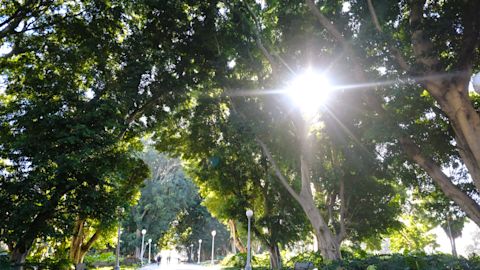We're continuing to expand our urban forest so that 27% of our area will be shaded by tree canopy by 2050 and getting the cool benefits.
Each year we plant more than 700 street trees. We do this, in part, to combat the heat island effect, but the benefits that trees bring people don’t stop there.
Trees are great for your physical and mental health
Trees are one of the most effective nature-based solutions to improve health. When it’s hot they shade and cool our homes, parks and streets. They also help create a better local environment for business while improving property values.
Crucially, trees have been found to maintain and improve mental and physical wellbeing.
In urban areas where more than 30% of space is covered by good shade, adults had lower odds of developing:
- cardiovascular disease (by 21%)
- diabetes (by 31%)
- psychological distress (by 31%)
- high blood pressure (by 17%)
- insufficient sleep of fewer than 6 hours a night (by 13%)
- poorer health in general (by 33%).
The benefits for those living in an area with more than 30% canopy cover are compared to people with zero, or very limited canopy cover (below 10%).
If you want to learn more about the findings from this research, you can read more in the International Journal of Epidemiology, JAMA Network Open, and SSM Population Health.

Connecting with nature does incredible things for you
If you can carve out a couple of hours a week to connect with nature the benefits are big, a recent international review of evidence in the Lancet Planetary Health found.
Among many benefits, this review reported reductions in systolic and diastolic blood pressure, moderate to large reductions in depression and anxiety scores, and increased physical activity – especially daily step counts – from getting into nature.

Professor Thomas Astell-Burt from the University of Wollongong has studied the health benefits of nature for over 10 years: “One in 3 adults spends less than 2 hours a week in nature, missing out on many health benefits. But 82% would accept a nature prescription from a health professional, so protecting and restoring tree canopy in our streets and parks is crucial to give everyone the opportunity to reconnect with nature.”

Sydney’s expanding urban forest
The City of Sydney has a clear plan to grow the city’s urban forest but also to make it more equitable. That means putting more trees in areas that have fewer trees right now to get the balance right.
Finding space to plant trees isn’t easy in a built-up city like ours. So, we might need to create new traffic islands and median strips to shade hot road surfaces, for example.
We want to make sure we get the right mix of trees too. No single tree is perfect, but a combination of native and exotic species, evergreen and deciduous, will help us achieve a more resilient urban forest.
Published 27 July 2023



